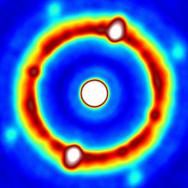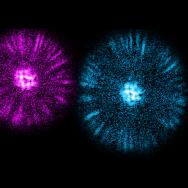Black holes fascinate the public and scientists alike because they are where it all breaks down: matter, unlucky stars and space flotsam, and our understanding of physics.
And while scientists have chipped away at their mysteries—from capturing the first image of one, to detecting the ripples in space-time they create when colliding—key parts of understanding black holes have escaped them. For example, Stephen Hawking suggested in 1974 that black holes actually emit a stream of warm radiation created by their extremely strong gravity; but of course, no one has been able to get close enough to a black hole to observe it.
Physicist William Unruh later suggested that the same type of radiation would appear if you were moving at a high enough acceleration; Einstein’s theory of general relativity confirms the equivalence between the two types of radiation. But Unruh radiation also has not been observed, since you would need to be accelerating tremendously fast just to see a tiny bit of the radiation—a G force on the order of a billion billion. (Fighter pilots top out at 10 Gs).
A team of physicists at the University of Chicago has built a quantum system to simulate the physics of this Unruh radiation. The breakthrough advances our understanding of these complex physics—and could ultimately help us explain how the largest and smallest phenomena in the universe fit together.
“This experiment shows a novel way to simulate physics in curved spacetimes,” said Prof. Cheng Chin, co-author of the study and a pioneer in using ultracold atoms to study the quantum phenomena that underlie the behavior of other particles in the universe. “Our scheme is a bit like building a flight simulator, which allows you to experience what it’s like to experience enormously large G forces while staying on the ground,” he said.
In Chin’s lab, a sample of atoms are first cooled down to near-zero temperature. Next, researchers apply an oscillating magnetic field on the sample and observe jets of atoms shooting outwards, which they termed “Bose fireworks.”
They also saw a coherence to the jets which reflects the quantum properties of Unruh radiation. “We realized that these emissions could also provide a new view into the quantum origin of Unruh radiation,” said Lei Feng, a graduate student and co-author on the study.
After some work manipulating the system to gain more control over the timing of the jets and collecting the data, they studied the results. The magnetic field plays the role of “flight simulator,” effectively recreating the effects of moving at extremely high acceleration, and the fireworks are a result of the Unruh radiation. Their discovery agreed excellently with Unruh’s predictions for the behavior of the radiation, including the temperature.
The scientists hope that studying the system will illuminate some of the physics at play in black holes and other extremes in the universe. That includes the information paradox, which points out the fundamental problem that black holes consume everything; although quantum mechanics holds that no information in the universe can ever be lost.
But scientists long to examine these phenomena, because they think it could shed light on a Holy Grail for any physicist: connecting the theory that describes the forces acting on the universe—from the largest scale, like gravity; to the smallest, like quantum mechanics. Right now, there are gaps in this alignment, which troubles physicists, who like to have one elegant theory that describes everything.
“It’s really a rare opportunity to have a tabletop experiment that could look at these physics,” Chin said. “And the other nice thing is that we can see both ‘sides’ of the phenomenon without having to go into a black hole,” Feng added.
The study’s first author was Jiazhong Hu (then a postdoctoral researcher at UChicago, now at Tsinghua University); the other coauthor was graduate student Zhendong Zhang. Support was provided by the Army Research Office, National Science Foundation, and the University of Chicago Materials Research Science and Engineering Center.
Citation: “Quantum simulation of Unruh radiation.” Hu et al, Nature Physics Letters, May 27, 2019.
Funding: National Science Foundation, U.S. Army Research Office, University of Chicago Materials Research Science and Engineering Centers

